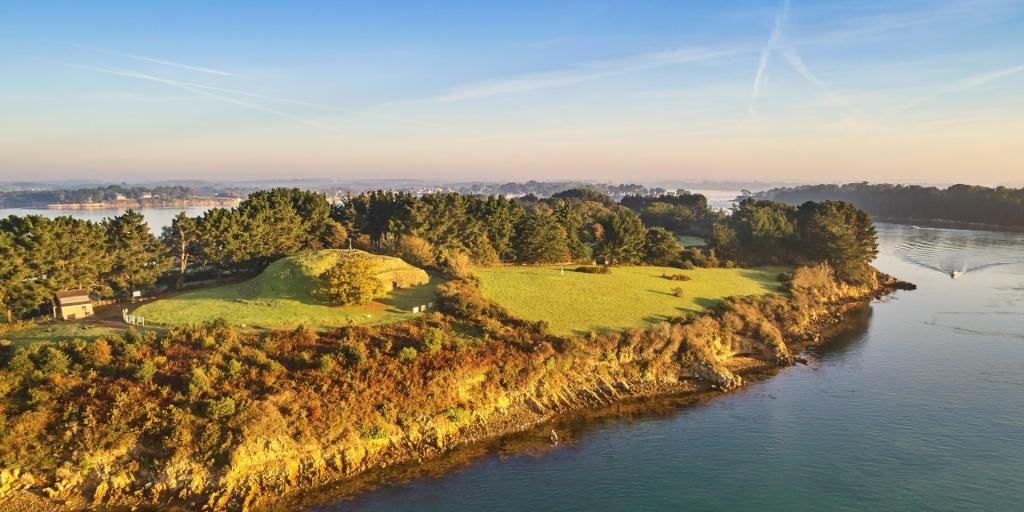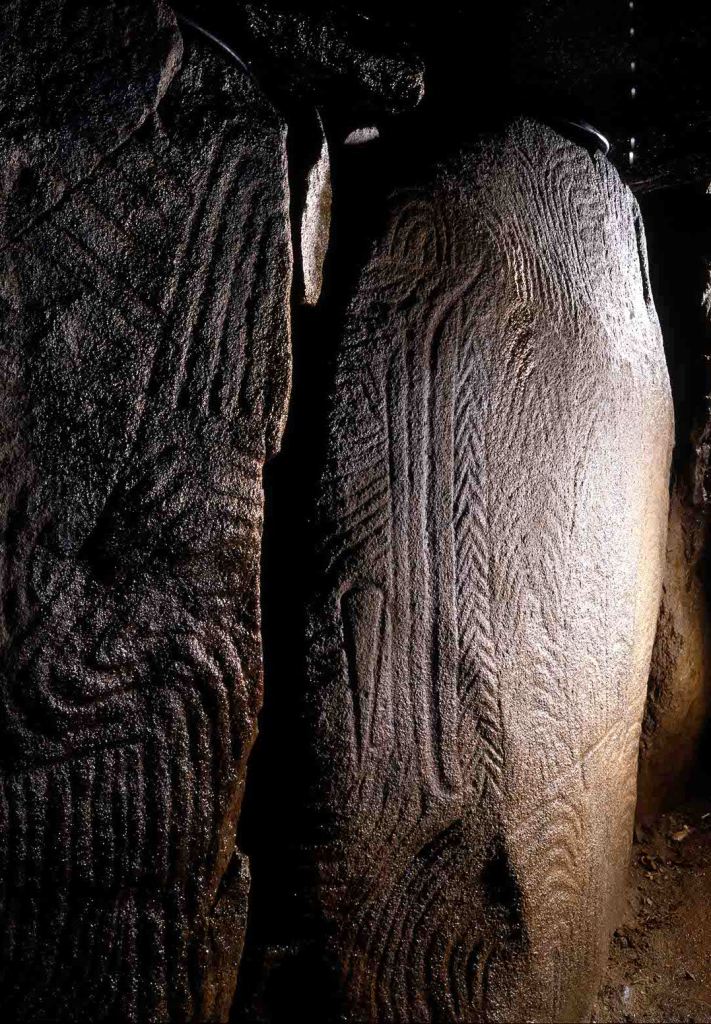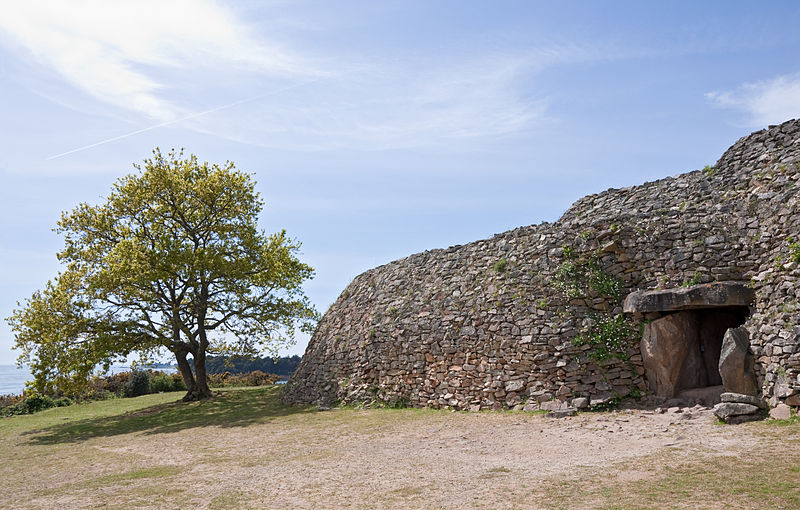For the latest in our Ancient Wonders series, we look to France over 5,000 years ago. On a small island in the Gulf of Morbihan in Brittany lies the Gavrinis Passage Tomb. The uninhabited island is formed from granite rock but is a tourist attraction for it holds the region’s most impressive Neolithic site.

The Gavrinis Passage Tomb is an ancient burial ground which is thought to have been constructed around 3,500 BC. The site features a stone burial chamber which is covered in a cairn, or stone mound, with a mound of earth packed on top of it. When the tomb was constructed thousands of years ago, the island of Gavrinis was still connected to the mainland.
The mound has a diameter of around 50m, but it has just a single 2.5 metre-wide burial chamber which lies at its centre. The walls of the chamber are made from around 50 stone slabs, with the huge ceiling slab weighing nearly 17 tonnes. In 1984, analysis of the ceiling slab found that it was cut from the same piece of stone that covers the stone burial chamber of Table des Marchand in Locmariaquer, just across the water from Gavrinis. It also matched a third stone at another tomb at Locmariaquer, and it has been suggested that the three pieces together once formed an enormous 14-metre standing stone.

The burial chamber is reached by a low, narrow passage which is 14 metres long and is covered in carved patterns and symbols which make Gavrinis so famous. There are 29 slabs which form the sides of the passage, 23 of which are decorated, making it one of the major surviving sources of megalithic art in Europe. The decoration is incredibly well preserved and consists of a variety of patterns. Some of the symbols are thought to be abstract depictions of items familiar to people living at the time, such as axes, shields and horns. There are plenty of other decorations which may have had meaning or may have been simply decorative, with zigzags, circles and other line styles.
The tomb and its passage were very carefully planned, for at the Winter Solstice the sun shines directly down the passage, hitting the back wall. The whole mound is 7 metres tall and made from thousands of small rocks piled together. It has a single entrance formed from three large slabs: two at the sides and one at the top. The tomb is a fantastic survival, and although the identity of the person (or people) buried inside the chamber has been lost to history, they must have been someone of very high status.

Around 3000 BC the site was abandoned for unknown reasons. There had been some wooden structures around the entrance which were burnt, and this caused the partial collapse of the mound, blocking the passage entrance. Over time, sand was blown over the mound and dirt and plants formed over it. This gave it the appearance of a natural hill, which allowed its remarkable survival for thousands of years.

Enjoying this blog post? Buy me a hot chocolate!
Consider donating the cost of a hot chocolate to me, so I can continue to write and run Just History Posts.
£3.50
The site was rediscovered in 1835 and was excavated at various points across the next century and a half. In the 1980s, serious studies and work was done on the site to unpick its history. In 1984, studies of the stone slabs showed that the external sides of some of them – now covered by the material of the rest of the mound – was also decorated, but in a different style to their internal faces. This has led to the suggestion that some of the stones had been used at different sites and monuments at an earlier period, then were re-used and re-carved for the purpose of the burial mound.

Today, the mound is a tourist attraction open between April and October by guided tour only. The site is accessed by a 15-minute boat ride from the nearby oyster-farming town of Larmor-Baden. It is certainly on my travel list!
Previous Blog Post: Historical Figures: Wilson Bentley, The Man Who Photographed Snowflakes
Previous in Ancient Wonders: The Colossus of Rhodes
List of Blog Posts: here Blog Homepage: here
Buy my books via the pictures below! Or why not check out our shop?

Follow us:
Read more:
https://www.brittanytourism.com/destinations/the-10-destinations/southern-brittany-morbihan-gulf/gavrinis/
https://www.megalithic.co.uk/article.php?sid=9254
https://thejournalofantiquities.com/2014/03/26/gavrinis-tumulus-gulf-of-morbihan-brittany-france/
https://www.atlasobscura.com/places/cairn-de-gavrinis






Hello 👋 really enjoyed your post and your amazing photos. I just finished a great book about this Gavrinis mound and other sacred places with carvings called The Memory Code by Dr Lynn Kelly https://www.goodreads.com/book/show/29759605-the-memory-code
Absolutely fascinating stuff, basically Kelly theorises that these monuments were memory aids to help people encode vast amounts of information. A review of the book coming up on my blog in a week or so. 😉🙂
LikeLike
That sounds like a fascinating book! Thank you for sharing – and glad you enjoyed the post.
LikeLike
It is a wonderful atmospheric place . Thank you for taking me back to it!
LikeLiked by 2 people
Oh have you been? I am very jealous, it looks incredible!
LikeLiked by 1 person
It is easy to get to and close to Carnac – once we can travel again!
LikeLiked by 2 people
Interesting article! It’s like a smaller version of Newgrange. Definitely a bucket list adventure.
LikeLiked by 2 people
Oh I hadn’t heard of that but it looks fab! Yes, it’s on my list too
LikeLiked by 1 person